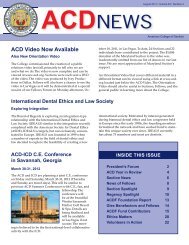JACD 71-4 - American College of Dentists
JACD 71-4 - American College of Dentists
JACD 71-4 - American College of Dentists
- No tags were found...
Create successful ePaper yourself
Turn your PDF publications into a flip-book with our unique Google optimized e-Paper software.
Dominick P. DePaola, DDS, FACD<br />
Abstract<br />
Leadership is characterized in terms<br />
<strong>of</strong> accomplishing mutual goals for the<br />
organization, its employees, and its<br />
community through vision and creating<br />
a community <strong>of</strong> caring. The examples<br />
<strong>of</strong> Herb Kelleher <strong>of</strong> Southwest Airlines,<br />
Walt Disney, and Dean Arthur A. Dugoni<br />
<strong>of</strong> the University <strong>of</strong> the Pacific are used<br />
to illustrate how this style <strong>of</strong> leadership<br />
plays out in specific accomplishments.<br />
Journal <strong>of</strong> the <strong>American</strong> <strong>College</strong> <strong>of</strong> <strong>Dentists</strong><br />
Leadership: Creating a Culture <strong>of</strong> Caring<br />
There are reams and reams <strong>of</strong> books,<br />
monographs, papers, symposia,<br />
and treatises on leadership. Some<br />
<strong>of</strong> the materials written on leadership<br />
describe long lists <strong>of</strong> traits <strong>of</strong> leaders,<br />
forms that leaders use to assess progress<br />
toward the attainment <strong>of</strong> their vision,<br />
and a variety <strong>of</strong> process issues that<br />
seemingly by magic turn a form into<br />
function resulting in leadership.<br />
In the same manner, a great number<br />
<strong>of</strong> historical and popular figures have<br />
been described as exemplary leaders.<br />
Interestingly, the range <strong>of</strong> the individuals<br />
so described as outstanding leaders<br />
spans an enormous scope—from John F.<br />
Kennedy, Martin Luther King, Jr., Caesar<br />
Augustus, Winston Churchill, Tom<br />
Peters, Stephen Covey, and Jack Welch to<br />
Attila and Tony Soprano. Unfortunately,<br />
there is no magical way to predict who<br />
will be an effective leader or to articulate<br />
the specific traits that leaders possess,<br />
either inherited or by learning. Indeed,<br />
many individuals can elegantly write<br />
about leadership or create constructs on<br />
and about leadership, but they simply<br />
do not know how to lead.<br />
It is abundantly clear that there is<br />
a great deal <strong>of</strong> intuition and inner<br />
“savvyness” to make things happen and<br />
when to “pull the trigger” or not. So,<br />
the intention <strong>of</strong> this essay is to discuss<br />
leadership in the context <strong>of</strong> individuals<br />
who have made and who continue to<br />
exemplify real leadership as differentiated<br />
from those who talk a good game! Of<br />
course, one <strong>of</strong> the former is Dr. Art<br />
Dugoni. Some <strong>of</strong> the others, whom I will<br />
describe briefly, are Walt Disney and<br />
Herb Kelleher, the co-founder and former<br />
Oral & Maxill<strong>of</strong>acial Surgery<br />
CEO <strong>of</strong> Southwest Airlines. It is hoped<br />
that you will see that all these individuals<br />
share some common traits and one<br />
truly exemplary characteristic, that is,<br />
they lead by example and by creating a<br />
culture <strong>of</strong> caring! In essence, they make<br />
things happen!<br />
Let me begin by sharing with you<br />
two working definitions <strong>of</strong> leadership<br />
and my summary thoughts. The first<br />
definition is elegantly described in Gary<br />
Wills’ wonderful book, Certain Trumpets:<br />
The Call <strong>of</strong> Leaders (1994). Wills defines<br />
a leader as one who mobilizes others<br />
toward a goal shared by leader and<br />
follower. Earlier, in Leadership for the<br />
21st Century (1991), Roast expanded<br />
Wills’ simplistic but elegant definition.<br />
Roast describes leadership as a dynamic<br />
relationship based on mutual influence<br />
and common purpose between leaders<br />
and collaborators in which both are<br />
moved to higher levels <strong>of</strong> motivation and<br />
moral development as they effect real,<br />
intended change. The figure describes<br />
these ingredients for successful and<br />
effective leadership.<br />
This figure suggests that leaders<br />
must have a vision <strong>of</strong> the future that is<br />
transparent to everyone, that has success<br />
measures embedded in the common<br />
goal, and that focuses on the “followers.”<br />
The latter is particularly important<br />
because to the extent “followers” are<br />
Dr. DePaola is President <strong>of</strong><br />
the Forsyth Institute, an oral<br />
health research center, in<br />
Boston.<br />
45





